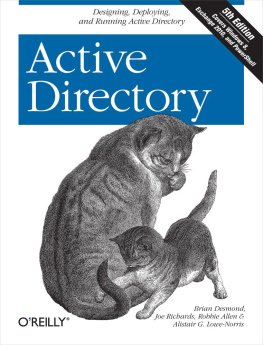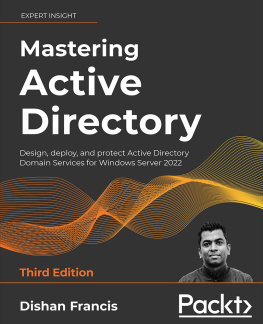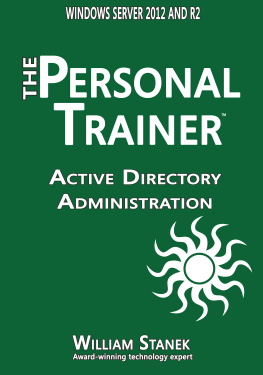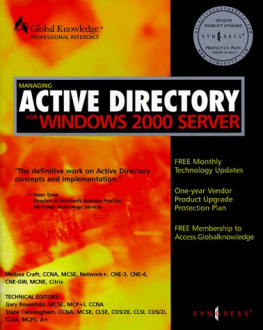Brian Desmond - Active Directory
Here you can read online Brian Desmond - Active Directory full text of the book (entire story) in english for free. Download pdf and epub, get meaning, cover and reviews about this ebook. year: 2008, publisher: OReilly Media, genre: Home and family. Description of the work, (preface) as well as reviews are available. Best literature library LitArk.com created for fans of good reading and offers a wide selection of genres:
Romance novel
Science fiction
Adventure
Detective
Science
History
Home and family
Prose
Art
Politics
Computer
Non-fiction
Religion
Business
Children
Humor
Choose a favorite category and find really read worthwhile books. Enjoy immersion in the world of imagination, feel the emotions of the characters or learn something new for yourself, make an fascinating discovery.

- Book:Active Directory
- Author:
- Publisher:OReilly Media
- Genre:
- Year:2008
- Rating:5 / 5
- Favourites:Add to favourites
- Your mark:
- 100
- 1
- 2
- 3
- 4
- 5
Active Directory: summary, description and annotation
We offer to read an annotation, description, summary or preface (depends on what the author of the book "Active Directory" wrote himself). If you haven't found the necessary information about the book — write in the comments, we will try to find it.
By giving you a thorough grounding in Active Directory, this bestselling book teaches you how to design, manage, and maintain an AD infrastructure, whether its for a small business network or a multinational enterprise with thousands of resources, services, and users. The fourth edition covers Active Directory from Windows 2000 through Windows Server 2008 in an easy-to-understand narrative style.
Active Directory — read online for free the complete book (whole text) full work
Below is the text of the book, divided by pages. System saving the place of the last page read, allows you to conveniently read the book "Active Directory" online for free, without having to search again every time where you left off. Put a bookmark, and you can go to the page where you finished reading at any time.
Font size:
Interval:
Bookmark:
Copyright 2008 O'Reilly Media, Inc.
OReilly books may be purchased for educational, business, or sales promotional use. Online editions are also available for most titles (.
Nutshell Handbook, the Nutshell Handbook logo, and the OReilly logo are registered trademarks of OReilly Media, Inc. Active Directory , the image of domestic cats, and related trade dress are trademarks of OReilly Media, Inc.
Many of the designations used by manufacturers and sellers to distinguish their products are claimed as trademarks. Where those designations appear in this book, and OReilly Media, Inc. was aware of a trademark claim, the designations have been printed in caps or initial caps.
While every precaution has been taken in the preparation of this book, the publisher and authors assume no responsibility for errors or omissions, or for damages resulting from the use of the information contained herein.

Supplemental files and examples for this book can be found at http://examples.oreilly.com/9780596520601/. Please use a standard desktop web browser to access these files, as they may not be accessible from all ereader devices.
All code files or examples referenced in the book will be available online. For physical books that ship with an accompanying disc, whenever possible, weve posted all CD/DVD content. Note that while we provide as much of the media content as we are able via free download, we are sometimes limited by licensing restrictions. Please direct any questions or concerns to .
Active Directory is a common repository for information about objects that reside on the network, such as users, groups, computers, printers, applications, and files. The default Active Directory schema supports numerous attributes for each object class that can be used to store a variety of information. Access Control Lists (ACLs) are also stored with each object, which allows you to maintain permissions for who can access and manage the object. Having a single source for this information makes it more accessible and easier to manage; however, to accomplish this requires a significant amount of knowledge on such topics as LDAP, Kerberos, DNS, multimaster replication, group policies, and data partitioning, to name a few. This book will be your guide through this maze of technologies, showing you how to deploy a scalable and reliable Active Directory infrastructure.
Windows 2000 Active Directory has proven itself to be very solid in terms of features and reliability, but after several years of real-world deployments, there was much room for improvement. When Microsoft released Windows Server 2003, they focused on security, manageability, and scalability enhancements. Windows Server 2003 R2 takes this evolution further and combines Windows Server 2003 Service Pack 1 with some feature packs, which makes Windows Server even more secure, manageable, and scalable and also adds considerable new functionality, such as a stand-alone LDAP server service and increased Unix system integration functions right in the box.
Windows Server 2008 introduces some highly sought-after features to Active Directory. At the top of the list for many administrators will be such features as read-only domain controllers, support for Server Core, and fine-grained password policies. The list of new features and major enhancements is lengthy, and we have taken the time to cover them all in this book.
This book is a major update to the very successful third edition. All of the existing chapters have been brought up to date with Windows Server 2008 changes, as well as updates in concepts and approaches to managing Active Directory and script updates. There are eight new chapters (Chapters that cover significant Windows Server 2008 Active Directory changes.
This book describes Active Directory in depth, but not in the traditional way of going through the graphical user interface screen by screen. Instead, the book sets out to tell administrators how to design, manage, and maintain a small, medium, or enterprise Active Directory infrastructure. To this end, the book is split up into three parts.
Part I introduces in general terms much of how Active Directory works, giving you a thorough grounding in its concepts. Some of the topics include Active Directory replication, the schema, application partitions, group policies, interaction with DNS, domain controllers, and password policies.
In Part II, we describe in copious detail the issues around properly designing the directory infrastructure. Topics include in-depth looks at designing the namespace, creating a site topology, designing group policies, auditing, permissions, backup and recovery, Active Directory Lightweight Directory Services, upgrading Active Directory, and Microsoft Exchange.
Part III is all about managing Active Directory via automation with Active Directory Service Interface (ADSI), ActiveX Data Objects (ADO), Windows Management Instrumentation (WMI), PowerShell, and .NET. This section covers how to create and manipulate users, groups, printers, and other objects that you may need in your everyday management of Active Directory. It also describes in depth how you can utilize the strengths of WMI, Windows PowerShell, and the .NET namespace System.DirectoryServices to manage Active Directory programmatically via those interfaces .
If youre looking for in-depth coverage of how to use the MMC snap-ins or Resource Kit tools, look elsewhere. However, if you want a book that lays bare the design and management of an enterprise or departmental Active Directory, you need not look any further.
This book is intended for all Active Directory administrators, whether you manage a single server or a global multinational with thousands of servers. Even if you have a previous edition, you will find this fourth edition to be full of updates and corrections and a worthy addition to your good bookshelf: the bookshelf next to your PC with the books you really read that are all dog-eared with soda drink spills and pizza grease on them. To get the most out of the book, you will probably find it useful to have a server running Windows Server 2008 available so that you can check out various items as we point them out.
If you have no experience with VBScript, the scripting language we use in Part III, dont worry. The syntax is straightforward, and you should have no difficulty grasping the principles of scripting with ADSI, ADO, and WMI. Likewise, the syntax we use in Part III to cover .NET is straightforward, and for those looking to learn PowerShell, provides a jumpstart to the PowerShell language.
This book is split into three parts.
Reviews the evolution of the Microsoft NOS and some of the major features and benefits of Active Directory.
Provides a high-level look at how objects are stored in Active Directory and explains some of the internal structures and concepts that it relies on.
Reviews the predefined Naming Contexts within Active Directory, what is contained within each, and the purpose of Application Partitions.
Gives you information on how the blueprint for each object and each objects attributes are stored in Active Directory.
Font size:
Interval:
Bookmark:
Similar books «Active Directory»
Look at similar books to Active Directory. We have selected literature similar in name and meaning in the hope of providing readers with more options to find new, interesting, not yet read works.
Discussion, reviews of the book Active Directory and just readers' own opinions. Leave your comments, write what you think about the work, its meaning or the main characters. Specify what exactly you liked and what you didn't like, and why you think so.





